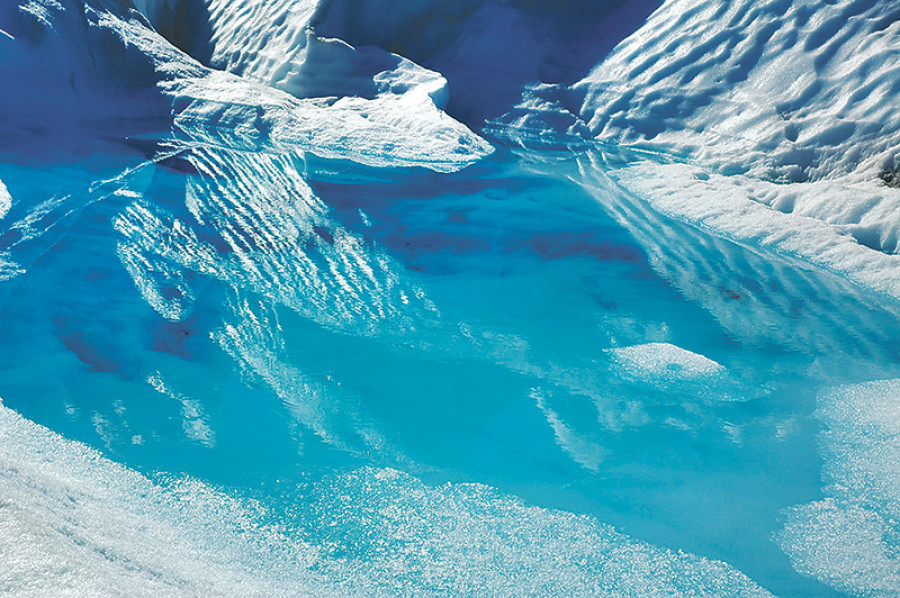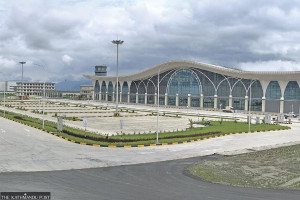Opinion
On thin ice
A latest study shows expanding icy ponds on debris-covered Himalayan glaciers could be key for future water issues
Navin Singh Khadka
The country may be too occupied with its heated politics to take note of its frozen resources in the Himalayan glaciers. But if a recent scientific finding in the Everest region is any indication, the ultra-frigid zone could play a huge role in the politics not just of the country, but of the entire region in the future.
The study on the Khumbu glacier has found that hundreds of icy ponds on Himalayan glaciers could hold the key for the region’s future water security. It says the icy ponds on debris-covered glaciers have been found to retain and release waters, regulating flow to downstream rivers that serve as lifelines to millions of people. Scientists involved in the study say these ponds could become more void and porous to hold more water in the future.
Solving a mystery
The findings have come against the backdrop of scientists’ struggle to establish where the water from accelerated glacial-melt in the Himalayas was going. In 2014, while releasing the fifth assessment report of the Intergovernmental Panel on Climate Change, the UN-body on climate science, lead authors of its cryosphere chapter told me that the whereabouts of the excess meltwater of the Himalayas was a mystery.
This latest study on the Khumbu glacier may have partially solved that puzzle.
“The hydrological role of ponds and debris may become more significant in the future,” the study’s lead author Tristram Irvine-Fynne, a glaciologist from the Aberystwyth University in the UK said in an interview I did for the BBC. “By understanding these processes we can become more confident in our predictions of water security and ecosystem response in the Himalaya.”
The findings of the study have been published in the journal, Geophysical Research Letters.
The scientists who did the field study on the Khumbu glacier found that the ponds caused some delays in meltwater delivery to the glacier’s margin. “The pattern of meltwater flow decline or the ‘flow recession” was really intriguing and didn’t seem to match the patterns that have been reported for clean ice glaciers in the Alps or Svalbard in the Arctic Circle,” said Dr Irvine-Fynne. Unlike in debris-covered glaciers, meltwater from clean glaciers—like the ones found in the poles—usually flow directly into rivers.
And it is not just about what is happening now; what could happen in the future is even more important, according to the researchers. “As these glaciers develop more and more of these ponds that we can see on the surface, they will also develop voids inside the ice as well and it will become more porous and it will be able to hold more and more of that water back,” said Duncan Quincy, another glaciologist of Leeds University who was also involved in the field study.
These scientists say icy ponds’ regulatory role as seen in the Everest region can be taken as a model for debris-covered glaciers in other parts of the Himalayas and, for that matter, also for other high mountains of the world.
Recent studies have shown several ponds and lakes have emerged, expanded and joined together on debris-covered glaciers of the Himalayas. Most of these have been linked to rising temperatures causing accelerated glacial meltdown. Another study in 2015 showed that the surface of the debris-covered Khumbu glacier in the Everest region has been declining at a rate of two metres per year.
Nearly 20 percent of the glaciers in the Himalayas are believed to be debris-covered while the figure for the Everest region is around 40 percent. There is no proper record of how many such ponds exist on the Himalayan glaciers. “The role debris covered glaciers are playing in the regulation of downstream water supply sounds entirely reasonable,” Alton Buyers, a glaciologist from University of Colorado, who was not involved in the study, told the BBC.
But he said the contribution of glacier melt to overall river water volume in the eastern Himalayas was very small. “The bulk of river water in Eastern Himalayas comes from monsoon precipitation from the lower watersheds,” he told me for a BBC report.
Accelerating risks of disaster
For Buyers, who has done several field studies of the Himalayan glaciers, the urgent issue in the wake of expanding ponds on debris-covered glaciers is water-related disaster. “Note that these supraglacial lakes are surficial expressions of a much more massive amount of water contained within the glacier,” he said. “Think of these debris covered glaciers as huge pieces of Swiss cheese, riddled with englacial conduits or caves and caverns that can become filled with water, many of them interconnected so that the sudden drainage of one can trigger the flooding of a dozen more.” Buyers said something like that did happen on the Lhotse glacier in 2016 and that such disasters are increasing in frequency.
Rising temperatures accelerating glacial-melt and dangerously filling up glacial lakes have already been a serious disaster risk in the Himalayas. And now coalescing ponds on glaciers appear to be making things worse.
While these are dangerous developments on the surface and inside glaciers, scientists say, changes might also be happening in the depths of the glacial ponds. They say rising temperatures warm the water of the ponds which means their beds will melt too, making them deeper and taking the water further down.
How much of such water is actually seeping into the ground, or how much of it will in the future?
“Actually how much of the water goes through the glacier down to sediment beneath and into the ground water reservoir and is released into the rivers much further downstream is still a big question,” said Dr Quincey.
The answer to that question will also hold the key for much of the future water availability in the region.
And that is where, experts say, water politics will shape the geopolitics.
Khadka is a BBC journalist based in London




 7.12°C Kathmandu
7.12°C Kathmandu










